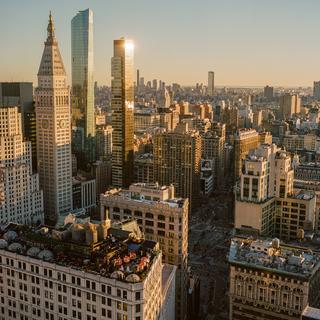


New York, the Native American city: 'This is our ancestral land. It holds their spirits, our stories'
InvestigationRobbed of their land by the Dutch in the 17th century, the Lenape left the region and traces of their past were erased. As the arrival of the first settlers is about to be celebrated, the Native Americans' descendants seek to perpetuate the memory of their forebears and claim their place in America's national narrative.
It's a little-known corner of Manhattan stretching along the northwestern tip of New York Island. On this January morning, the gaunt trees and gray skies didn't do justice to the beauty of Inwood Hill, where green becomes the predominant color when the weather gets nice. The 79-hectare park is home to Manhattan's last remaining natural forest, which is also its oldest. Relatively untouched, the site is one of the few living remnants of a New York that has since disappeared, buried under asphalt and skyscrapers. The park is very close to Joe Baker's heart, a descendant of the Lenape, the native people who inhabited the area before European colonization in the 17th century. "This is our Lenape ancestral land," he explained. "It holds the spirits of our ancestors, our stories as does the entire island."
As various historical organizations this year prepare to commemorate the 400th anniversary of the first Dutch settlers in what became New Amsterdam and then New York, Baker is one of those struggling to make his people's voices heard. With the Lenape Center, a non-profit organization he co-founded in 2009 and heads alongside Curtis Zunigha, Brent Michael Davids and Hadrien Coumans, he is fighting to affirm the place of the Lenape in a narrative told primarily from a European perspective, to bring their culture back to their ancestral land and offer new opportunities to his people.
In the Upper East Side café where he arranged to meet, the 77-year-old with graying hair spoke in a low voice. He listed the names of his ancestors, including a long line of Lenape leaders, a people also known as Delaware. His forefather, Chief White Eyes, was among those who negotiated the Treaty of Fort Pitt in 1778, the first peace accord signed by the fledgling US with an indigenous nation. "There's a direct descendancy in my family that goes back to the very beginnings of European contact," said this artist, who moved to Manhattan in 2020. "It is because of that I'm privileged and honored to do the work I do. Because what our ancestors had to face on the ground floor is not unlike what we face today, with a continuous, consistent erasure of our presence in Manhattan."
'A Eurocentric worldview'
Who knew that the island, a cradle of Dutch and British colonialism before the US independence in 1776, takes its name from the Lenape Manahatta? That the famous Broadway Avenue, then called Wickquasgeck, was one of the Lenape's main trails? That Pearl Street was named after the heaps of oyster shells left behind by the Lenape? And that for Baker and his family, Wall Street, named after a wall built to protect the fledgling Dutch colony, is one of the last vestiges of the violence their forebears had to face?
You have 88.05% of this article left to read. The rest is for subscribers only.
